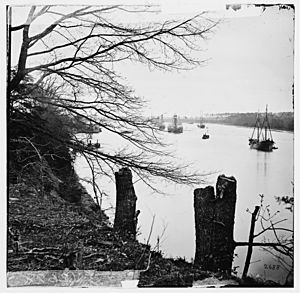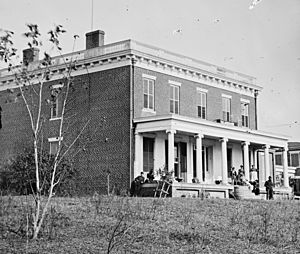Varina, Virginia facts for kids
Quick facts for kids
Varina, Virginia
|
|
|---|---|
|
Former unincorporated community and current magisterial district
|
|
| Country | United States |
| State | Virginia |
| County | Henrico |
| Named for | Varina plantation |
Varina (/vəˈraɪnə/ və-RY-nə) is a historic area in Henrico County, Virginia, United States. It used to be an unincorporated community, meaning it was part of the county but didn't have its own local government. Today, Varina is a magisterial district, which is a local government area within the county.
Contents
History of Varina
Varina has a long and interesting history, dating back to the early days of the Virginia Colony. It played an important role in the development of the region.
Early Beginnings
The name Varina first appeared in records around 1632. It was linked to a large farm called Varina Plantation. For a long time, people incorrectly believed that the famous figures John Rolfe and Pocahontas were connected to Varina Plantation.
Becoming a County Seat
After a Native American attack in 1622, the original settlement of Henricus declined. The Varina settlement then grew up around the Varina Plantation. Varina became the county seat of Henrico County in 1634. A county seat is the main town where the county government is located. Henrico was one of the eight original areas, called shires, in Virginia.
In 1666, the first courthouse for Henrico County was built in Varina. By 1680, Varina was officially recognized as an unincorporated community. This meant it was a settled area, but without its own separate town government.
Around 1640, a church for Henrico Parish and other buildings were constructed in or near Varina. The exact location of these early buildings is not known today. Varina was also home to the "glebe" of Henrico Parish. A glebe was land provided to support the church minister.
From 1685 to 1694, Reverend James Blair was the minister at Varina Parish. He later became the first leader of the College of William & Mary in 1694, which he helped to create. After Blair, William Stith lived at the glebe in Varina.
In 1741, the Henrico Parish church moved to its current location, which is now St. John's Episcopal Church in Richmond. Varina remained the county seat of Henrico County until 1752. At that time, the county government moved to the growing city of Richmond. Richmond was located at the head of navigation on the James River, meaning it was as far upriver as large ships could easily travel.
Historic Places in Varina
Varina is home to several historic districts and important sites. These include Cedar Hill, Armour House, Curles Neck, Dabbs House, Dorey Barn, Gravel Hill, and Osborne School House.
One of the oldest properties is Curles Neck Plantation. In 1635, Captain Thomas Harris received a land patent for 750 acres here. A land patent is like an official document granting ownership of land. Harris was a representative for Curles Neck in the House of Burgesses, which was an early form of government in Virginia. His house was one of the oldest in Virginia. Its ruins have been studied by archaeologists.
The property later became known as Curles Neck Plantation. It was home to Nathaniel Bacon, who led a rebellion against the colonial government in the 1670s. Bacon lived there from 1674 until his death in 1676. After his rebellion, the British government took over the property. In 1698, the Randolph family of Virginia bought it and owned it for a very long time. The main house, built in the Georgian style, is thought to have been destroyed during the Civil War.
Dabbs House was a large home from the Antebellum South (the period before the Civil War). It is now used as the eastern headquarters for the Henrico Division of Police. The famous Chief Justice John Marshall also owned a country home nearby in the early 1800s.
Cedar Hill is another historic farmhouse, built in the Greek Revival style in the 1800s. The owner, James D. Vaughan, served in the 10th Regiment of the Virginia Cavalry during the Civil War. The house has been moved from its original spot and is part of a restoration project.
Varina During the Civil War
During the Civil War (1861–1865), Varina was a very important location. Robert E. Lee, a famous Confederate general, used Clover Forest Plantation as his headquarters for a time. The Seven Days Battle in 1862, a major series of fights, began in the Varina area. General Lee could watch the battle from a high point that is now Meadowview Park. Cedar Hill was also used as a camp for Confederate soldiers during these battles.
Varina was one of only two main places in the South where Union and Confederate armies exchanged prisoners during the war. Union General Benjamin Butler took over the Varina Plantation for his headquarters, and his staff lived in the house and cabins there.
Changes in Economy
As Richmond grew into a major city and port in the mid-1700s, and as roads improved, Varina became more isolated. It was not on any major roadways. Because of this, the area gradually became mainly used for farming.
Archaeological Discoveries
Archaeologists have found evidence of Native American settlements in Meadowview Park that date back to prehistoric times. This shows that people lived in the Varina area long before European settlers arrived.
See also
 In Spanish: Varina (Virginia) para niños
In Spanish: Varina (Virginia) para niños




